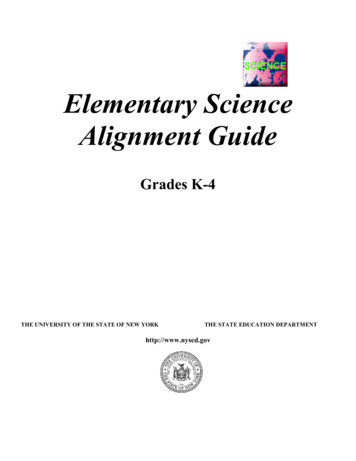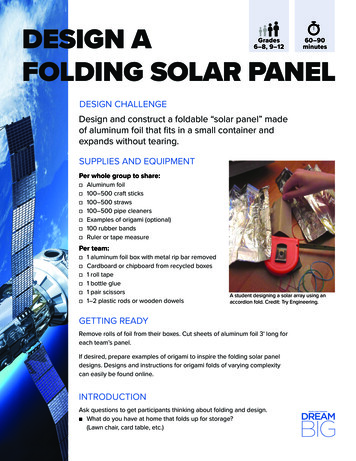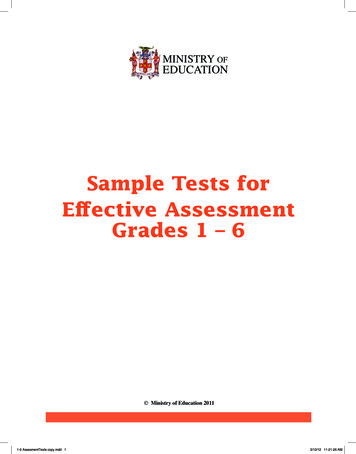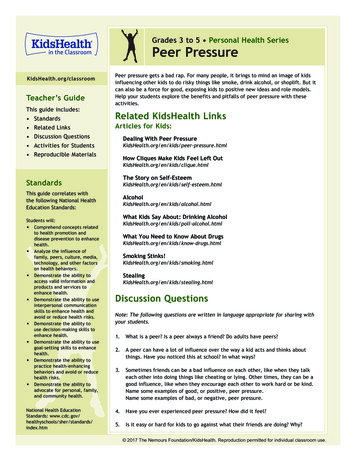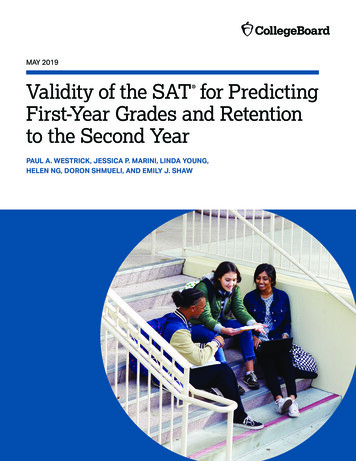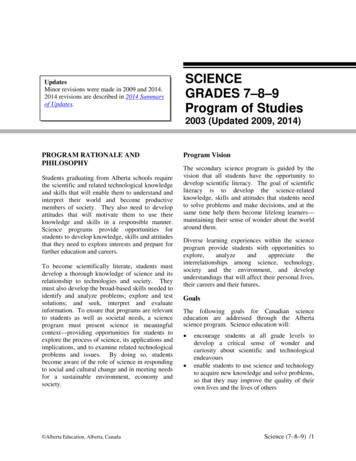
Transcription
UpdatesMinor revisions were made in 2009 and 2014.2014 revisions are described in 2014 Summaryof Updates.SCIENCEGRADES 7–8–9Program of Studies2003 (Updated 2009, 2014)PROGRAM RATIONALE ANDPHILOSOPHYStudents graduating from Alberta schools requirethe scientific and related technological knowledgeand skills that will enable them to understand andinterpret their world and become productivemembers of society. They also need to developattitudes that will motivate them to use theirknowledge and skills in a responsible manner.Science programs provide opportunities forstudents to develop knowledge, skills and attitudesthat they need to explore interests and prepare forfurther education and careers.To become scientifically literate, students mustdevelop a thorough knowledge of science and itsrelationship to technologies and society. Theymust also develop the broad-based skills needed toidentify and analyze problems; explore and testsolutions; and seek, interpret and evaluateinformation. To ensure that programs are relevantto students as well as societal needs, a scienceprogram must present science in meaningfulcontext—providing opportunities for students toexplore the process of science, its applications andimplications, and to examine related technologicalproblems and issues. By doing so, studentsbecome aware of the role of science in respondingto social and cultural change and in meeting needsfor a sustainable environment, economy andsociety. Alberta Education, Alberta, CanadaProgram VisionThe secondary science program is guided by thevision that all students have the opportunity todevelop scientific literacy. The goal of scientificliteracy is to develop the science-relatedknowledge, skills and attitudes that students needto solve problems and make decisions, and at thesame time help them become lifelong learners—maintaining their sense of wonder about the worldaround them.Diverse learning experiences within the scienceprogram provide students with opportunities s among science, technology,society and the environment, and developunderstandings that will affect their personal lives,their careers and their futures.GoalsThe following goals for Canadian scienceeducation are addressed through the Albertascience program. Science education will: encourage students at all grade levels todevelop a critical sense of wonder andcuriosity about scientific and technologicalendeavoursenable students to use science and technologyto acquire new knowledge and solve problems,so that they may improve the quality of theirown lives and the lives of othersScience (7–8–9) /1
prepare students to critically address sciencerelated societal, economic, ethical andenvironmental issuesprovide students with a foundation in sciencethat creates opportunities for them to pursueprogressively higher levels of study, preparesthem for science-related occupations, andengages them in science-related hobbiesappropriate to their interests and abilitiesenable students, of varying aptitudes andinterests, to develop a knowledge of the widespectrum of careers related to science,technology and the environment.2/ Science (7–8–9) Alberta Education, Alberta, Canada
PROGRAM FOUNDATIONSTo support the development of science literacy, school programs must provide a foundation of learningexperiences that address critical aspects of science and its application. These critical areas—thefoundations of the program—provide general direction for the program and identify major components ofits structure.Program Rationale and Philosophy Foundation 1Foundation 2Foundation 3Foundation 4KNOWLEDGESKILLSATTITUDESNature of ScienceLife ScienceInterest in ScienceScience andTechnologyPhysicalScienceInitiating andPlanningSCIENCE,TECHNOLOGYAND SOCIETY(STS)Social andEnvironmentalContexts ofScience andTechnology Earth and SpaceScience Performing andRecordingAnalyzing andInterpretingCommunicationand TeamworkMutual Respect Scientific InquiryCollaborationStewardshipSafetyFoundation 1Science, Technology and Society (STS)—Students will develop an understanding of the nature ofscience and technology, the relationships between science and technology, and the social andenvironmental contexts of science and technology.Foundation 2Knowledge—Students will construct knowledge and understandings of concepts in life science, physicalscience and Earth and space science, and apply these understandings to interpret, integrate and extendtheir knowledge.Foundation 3Skills—Students will develop the skills required for scientific and technological inquiry, for solvingproblems, for communicating scientific ideas and results, for working collaboratively and for makinginformed decisions.Foundation 4Attitudes—Students will be encouraged to develop attitudes that support the responsible acquisition andapplication of scientific and technological knowledge to the mutual benefit of self, society and theenvironment. Alberta Education, Alberta, CanadaScience (7–8–9) /3
Foundation 1:Society (STS)Science, Technology andFoundation 1 is concerned with understanding thescope and character of science, its connections totechnology, and the social context in which it isdeveloped. The following is a brief introductionto the major ideas that underlie this component ofthe program.Nature of ScienceScience provides an ordered way of learning aboutthe nature of things, based on observation andevidence. Through science, we explore ourenvironment, gather knowledge and develop ideasthat help us interpret and explain what we see.Scientific activity provides a conceptual andtheoretical base that is used in predicting,interpreting and explaining natural andtechnological phenomena. Science is driven by acombination of specific knowledge, theory andexperimentation.Science-based ideas arecontinually being tested, modified and improvedas new knowledge and explanations supersedeexisting knowledge and explanations.Science and TechnologyTechnology is concerned with solving practicalproblems that arise from human needs.Historically, the development of technology hasbeen strongly linked to the development ofscience, with each making contributions to theother. While there are important relationships andinterdependencies, there are also importantdifferences. Where the focus of science is on thedevelopment and verification of knowledge, intechnology the focus is on the development ofsolutions, involving devices and systems that meeta given need within the constraints of the problem.The test of science knowledge is that it helps usexplain, interpret and predict; the test oftechnology is that it works—it enables us toachieve a given purpose.Social and Environmental Contexts of Scienceand TechnologyThe history of science shows that scientificdevelopment takes place within a social context.Many examples can be used to show that culturaland intellectual traditions have influenced thefocus and methodologies of science, and thatscience in turn has influenced the wider world ofideas.4/ Science (7–8–9)Today, research is often driven by societal andenvironmental needs and issues. As technologicalsolutions have emerged from previous research,many of the new technologies have given rise tocomplex social and environmental issues.Increasingly, these issues are becoming part of thepolitical agenda. The potential of science toinform and empower decision making byindividuals, communities and society is a centralrole of scientific literacy in a democratic society.Foundation 2: KnowledgeFoundation 2 focuses on the subject matter ofscience, including the theories, models, conceptsand principles that are essential to anunderstanding of each science area.Fororganizational purposes, this foundation is framedusing widely accepted science disciplines.Life ScienceLife science deals with the growth and interactionsof life forms within their environments in waysthat reflect their uniqueness, diversity, geneticcontinuity and changing nature. Life scienceincludes such fields of study as ecosystems,biological diversity, the study of organisms, thestudy of the cell, biochemistry, geneticengineering and biotechnology.Physical SciencePhysical science, which encompasses chemistryand physics, deals with matter, energy and forces.Matter has structure, and there are interactionsamong its components. Energy links matter togravitational, electromagnetic and nuclear forcesin the universe. The conservation laws of massand energy, momentum and charge, are addressedin physical science.Earth and Space ScienceEarth and space science brings global anduniversal perspectives to student knowledge.Earth, our home planet, exhibits form, structureand patterns of change, as does our surroundingsolar system and the physical universe beyond it.Earth and space science includes such fields ofstudy as geology, meteorology and astronomy. Alberta Education, Alberta, Canada
Foundation 3: SkillsFoundation 3 is concerned with the skills thatstudents develop in answering questions, solvingproblems and making decisions. While theseskills are not unique to science, they play animportant role in the development of scientificunderstandings and in the application of scienceand technology to new situations. Four broad skillareas are outlined in this program of studies. Eachskill area is developed at each grade level withincreasing scope and complexity of application.Initiating and PlanningThese are the skills of questioning, identifyingproblems, and developing preliminary ideas andplans.Performing and RecordingThese are the skills of carrying out a plan of actionthat involves gathering evidence by observationand, in most cases, manipulating materials andequipment.Analyzing and InterpretingThese are the skills of examining information andevidence; processing and presenting data so that itcan be interpreted; and interpreting, evaluating andapplying the results.Communication and TeamworkIn science, as in other areas, communication skillsare essential at every stage where ideas are beingdeveloped, tested, interpreted, debated and agreedupon. Teamwork skills are also important, as thedevelopment and application of science ideas is acollaborative process both in society and in theclassroom.Foundation 4: AttitudesFoundation 4 is concerned with generalizedaspects of behaviour—commonly referred to asattitudes. Attitude outcomes are of a differentform than outcomes for skills and knowledge:they are exhibited in a different way, and theyhave deeper roots in the experiences that students Alberta Education, Alberta, Canadabring to school. Attitude development is a lifelongprocess that involves the home, the school, thecommunity and society at large. Attitudes are bestshown not by the events of a particular momentbut by the pattern of behaviours over time.Development of positive attitudes plays animportant role in students’ growth by interactingwith their intellectual development and creating areadiness for responsible application of what islearned.Interest in ScienceStudents will be encouraged to developenthusiasm and continuing interest in the study ofscience.Mutual RespectStudents will be encouraged to appreciate thatscientific understanding evolves from theinteraction of ideas involving people with differentviews and backgrounds.Scientific InquiryStudents will be encouraged to develop attitudesthat support active inquiry, problem solving anddecision making.CollaborationStudents will be encouraged to develop attitudesthat support collaborative activity.StewardshipStudents will be encouraged to developresponsibility in the application of science andtechnology in relation to society and the naturalenvironment.SafetyStudents will be encouraged to demonstrate aconcern for safety in science and technologycontexts.Science (7–8–9) /5
PROGRAM ORGANIZATION ANDFORMATThis program of studies is organized into units asoutlined below.Unit ofStudyGrade 7Grade 8Grade 9AInteractionsandEcosystemsMix andFlow ofMatterBiologicalDiversityBPlants forFood andFibreCells andSystemsMatter andChemicalChangeCHeat andTemperatureLight and ForcesMechanicalSystemsElectricalPrinciples andTechnologiesEPlanet EarthFreshwaterand SaltwaterSystemsSpaceExplorationUnit OrganizationIn Grade 7, Grade 8 and Grade 9, five units ofstudy are outlined.Each unit includes thefollowing components.Unit OverviewEach unit of study begins with an overview thatintroduces the contents of the unit and suggests anapproach to its development.Focusing QuestionsThese questions frame a context for introducingthe unit and suggest a focus for investigativeactivities and application of ideas by students.OutcomesTwo levels of outcomes are provided in thisprogram of studies. General Outcomes: These are the majoroutcomes for each unit. For Foundations 1and 2 (STS and knowledge), the outcomes arecombined and unique to each unit. ForFoundation 3 (skills) and Foundation 4(attitudes), the outcomes are common to allunits.Specific Outcomes:These are detailedoutcomes that flesh out the scope of each unit.They are shown in bulleted form.ExamplesMany of the outcomes are supported by examples.The examples do not form part of the requiredprogram but are provided as an illustration ofhow the outcomes might be developed.Illustrative examples are written in italics and areseparated from the outcomes by being placed inparentheses.Links to Mathematics (Grade 9 only)The purpose of the links to mathematics is toidentify mathematical concepts and skills relatedto science content in the science units of study.The mathematics links identify where similarconcepts and skills are developed in themathematics programs of study to support makingconnections between mathematics and sciencelearning, to build upon previous student learning,and to identify possible connections tomathematics learning that students mayencounter. These links do not represent learningoutcomes for science and are not consideredprerequisites for Alberta science courses.Key ConceptsKey concepts identify major ideas to be developedin each unit. Some of the key concepts may beaddressed in additional units at the same gradelevel, as well as at other grade/course levels. Theintended scope of treatment of these concepts isindicated by the outcomes.6/ Science (7–8–9) Alberta Education, Alberta, Canada
Unit EmphasesEach unit of study begins with an overview and aset of focusing questions that identify a context forstudy. In defining the context, one of thefollowing areas of emphasis is identified for eachunit. Nature of Science Emphasis: In these units,student attention is focused on the processesby which scientific knowledge is developedand tested, and on the nature of the scientificknowledge itself. The skills emphasized inthese units are the skills of scientific inquiry.Science and Technology Emphasis: In theseunits, students seek solutions to practicalproblems by developing and testingprototypes, products and techniques to meet agiven need. The skills emphasized are thoseof problem solving, in combination with theskills of scientific inquiry.Social and Environmental Emphasis: In theseunits, student attention is focused on issuesand decisions relating to how science andtechnology are applied. Skill emphasis is onthe use of research and inquiry skills to informthe decision-making process; students seekand analyze information and consider a varietyof perspectives. Alberta Education, Alberta, CanadaScience (7–8–9) /7
Developing a Nature of Science Emphasis (Grades 7–9)An emphasis on the Nature of Science provides opportunities to develop the following concepts andskills.Concepts The goal of science is knowledge about thenatural world. Scientific knowledge develops throughobservation, experimentation, the discoveryof patterns and relationships, and theproposal of explanations. Scientific knowledge results from the sharedwork of many people over time. Scientific knowledge is subject to change asnew evidence is gathered and newinterpretations of data are made. The process of scientific investigationincludes:– clearly defining research questions orideas to be tested– developing procedures for investigation– preparingaccuraterecordsofobservations and measurements– evaluating ideas through criticalexamination of evidence. Scientific ideas are conceptual inventionsthat help organize, interpret and explainfindings. Models and theories are often used ininterpretingandexplainingobservations, and in predicting futureobservations. Conventions of nomenclature andnotation provide a basis for organizingand communicating science knowledge;e.g., chemical symbols. Scientific language is precise, andspecific terms may be used in each fieldof study. Science cannot provide complete answers toall questions.8/ Science (7–8–9)Skills (focus on scientific inquiry)Initiating and Planning; e.g., identify questions to investigate define and delimit questions to facilitateinvestigation state a prediction and a hypothesis based onbackground information or an observed patternof events select appropriate methods and tools forcollecting data and information.Performing and Recording; e.g., carry out procedures, controlling the majorvariables use appropriate instruments effectively andaccurately for collecting data organize data, using a format that is appropriateto the task or experiment use apparatus safely.Analyzing and Interpreting; e.g., interpret patterns and trends in data, and inferand explain relationships among the variables predict the value of a variable by interpolating orextrapolating from graphical data identify and suggest explanations fordiscrepancies in data state a conclusion, based on experimental data,and explain how evidence gathered supports orrefutes an initial idea.Communication and Teamwork; e.g., work cooperatively with team members todevelop and carry out a plan and troubleshootproblems as they arise recommend an appropriate way of summarizingand interpreting findings evaluate individual and group processes used inplanning and carrying out investigative tasks. Alberta Education, Alberta, Canada
Developing a Science and Technology Emphasis (Grades 7–9)An emphasis on the Science–Technology connection provides opportunities to develop the followingconcepts and skills.Concepts The goal of technology is to providesolutions to practical problems. Technological development may involve trialand error, as well as application ofknowledge from related scientific fields. Technologicalproblemsoftenlendthemselves to multiple solutions, involvingdifferent designs, materials and processes. Scientific knowledge may lead to thedevelopment of new technologies, and newtechnologies may lead to scientific discovery. The process for technological developmentincludes:– clearly defining problems to be solvedand requirements to be met– developing designs and prototypes testing and evaluating designs andprototypes. The products of technology are devices,systems and processes that meet given needs. The appropriateness of technologies needs tobe assessed for each potential application—aproposed technological solution may not beappropriate to the context.Skills (focus on problem solving)Initiating and Planning; e.g., define practical problems identify questions to investigate arising frompractical problems propose alternative solutions to a given practicalproblem, select one, and develop a plan select appropriate methods and tools forcollecting data and information and for solvingproblems.Performing and Recording; e.g., research information relevant to a given problem construct and test prototype designs use tools and apparatus safely.Analyzing and Interpreting; e.g., identify and troubleshoot problems, and refinethe operation of prototype devices evaluate designs and prototypes in terms offunction, reliability, safety, efficient use ofmaterials and impact on the environment identify and evaluate potential applications offindings identify new questions and problems that arisefrom what was learned.Communication and Teamwork; e.g., work cooperatively with team members todevelop and carry out a plan and troubleshootproblems as they arise recommend an approach to solving a givenproblem, based on findings evaluate individual and group processes used inplanning and carrying out problem-solvingtasks. Alberta Education, Alberta, CanadaScience (7–8–9) /9
Developing a Social and Environmental Emphasis (Grades 7–9)An emphasis on the Social–Environmental connection provides opportunities to develop the followingconcepts and skills.Concepts Science and technology are developed tomeet human needs and expand humancapability. Science and technology have contributed tohuman well-being and have influenced, andbeen influenced by, social development. Science and technology have both intendedand unintended consequences for humansand the environment. Society provides direction for scientific andtechnological development. Canadian society supports scientificresearch and technological developmentthat helps achieve a sustainable society,economy and environment. Decisions regarding scientific andtechnological development involve avariety of considerations, including social,environmental, ethical and economicconsiderations. Societysupportsscientificandtechnological development by ing results, and providingfinancial support. Scientific and technological activity mayarise from, and give rise to, such personaland social values as accuracy, honesty,perseverance, tolerance, open-mindedness,critical-mindedness, creativity and curiosity. Science and technology provide opportunitiesfor a diversity of careers, for the pursuit ofhobbies and interests, and for meetingpersonal needs.10/ Science (7–8–9)Skills (focus on research and inquiry skills toinform the decision-making process)Initiating and Planning; e.g., identify science-related issues identify questions to investigate arising fromscience-related issues select appropriate methods and tools forcollecting relevant data and information.Performing and Recording; e.g., research information relevant to a givenquestion, problem or issue identify information and data that arerelevant to the issue select and integrate information from variousprint and electronic sources, or from severalparts of the same source.Analyzing and Interpreting; e.g., apply given criteria for evaluating evidenceand sources of information identify new questions and problems thatarise from what was learned identify and evaluate potential applications offindings.Communication and Teamwork; e.g., work cooperatively with team members todevelop and carry out a plan and troubleshootproblems as they arise defend a given position on an issue, based onfindings evaluate individual and group processes usedin investigating an issue and in evaluatingalternative decisions. Alberta Education, Alberta, Canada
GRADE 7Unit A: Interactions and Ecosystems (Social and Environmental Emphasis)Overview: Ecosystems develop and are maintained by natural processes and are affected by humanaction. To foster an understanding of ecosystems, this unit develops student awareness of ecosystemcomponents and interactions, as well as natural cycles and processes of change. Building on thisknowledge, students investigate human impacts and engage in studies that involve environmentalmonitoring and research. By reflecting on their findings, students become aware of the intended andunintended consequences of human activity, and recognize the need for responsible decision making andaction.Focusing Questions: How do human activities affect ecosystems? What methods can we use to observeand monitor changes in ecosystems, and assess the impacts of our actions?Key ConceptsThe following concepts are developed in this unit and may also be addressed in other units at other gradelevels. The intended level and scope of treatment is defined by the outcomes below. interactions and interdependenciesenvironmental monitoringenvironmental impactsproducers, consumers, decomposersnutrient cycles and energy flow species distributionsuccessionendangered speciesextinctionenvironmental managementOutcomes for Science, Technology and Society (STS) and KnowledgeStudents will:1. Investigate and describe relationships between humans and their environments, and identify relatedissues and scientific questions illustrate how life-supporting environments meet the needs of living things for nutrients, energysources, moisture, suitable habitat, and exchange of gases describe examples of interaction and interdependency within an ecosystem (e.g., identifyexamples of dependency between species, and describe adaptations involved; identify changingrelationships between humans and their environments, over time and in different cultures—as, forexample, in aboriginal cultures) identify examples of human impacts on ecosystems, and investigate and analyze the link betweenthese impacts and the human wants and needs that give rise to them (e.g., identify impacts of theuse of plants and animals as sources of food, fibre and other materials; identify potential impactsof waste products on environments) analyze personal and public decisions that involve consideration of environmental impacts, andidentify needs for scientific knowledge that can inform those decisions2. Trace and interpret the flow of energy and materials within an ecosystem analyze an ecosystem to identify biotic and abiotic components, and describe interactions amongthese components analyze ecosystems to identify producers, consumers and decomposers; and describe how energyis supplied to and flows through a food web, by: describing and giving examples of energy and nutrient storage in plants and animals describing how matter is recycled in an ecosystem through interactions among plants,animals, fungi, bacteria and other microorganisms interpreting food webs, and predicting the effects of changes to any part of a webUnit A: Interactions and Ecosystems Alberta Education, Alberta, CanadaGrade 7 Science /11
describe the process of cycling carbon and water through an ecosystemidentify mechanisms by which pollutants enter and move through the environment, and canbecome concentrated in some organisms (e.g., acid rain, mercury, PCBs, DDT)3. Monitor a local environment, and assess the impacts of environmental factors on the growth, healthand reproduction of organisms in that environment investigate a variety of habitats, and describe and interpret distribution patterns of living thingsfound in those habitats (e.g., describe and compare two areas within the school grounds—arelatively undisturbed site and a site that has been affected by heavy use; describe and comparea wetland and a dryland area in a local parkland) investigate and interpret evidence of interaction and change (e.g., population fluctuations,changes in weather, availability of food or introduction of new species into an ecosystem) identify signs of ecological succession in local ecosystems (e.g., emergence of fireweed inrecently cut forest areas, replacement of poplar by spruce in maturing forests, reestablishment ofnative plants on unused farmland)4. Describe the relationships among knowledge, decisions and actions in maintaining life-supportingenvironments identify intended and unintended consequences of human activities within local and globalenvironments (e.g., changes resulting from habitat loss, pest control or from introduction of newspecies; changes leading to species extinction) describe and interpret examples of scientific investigations that serve to inform environmentaldecision making illustrate, through examples, the limits of scientific and technological knowledge in makingdecisions about life-supporting environments (e.g., identify limits in scientific knowledge of theimpact of changing land use on individual species; describe examples in which aboriginalknowledge—based on long-term observation—provides an alternative source of understanding) analyze a local environmental issue or problem based on evidence from a variety of sources, andidentify possible actions and consequences (e.g., analyze a local issue on the control of thebeaver population in a nearby wetland, and identify possible consequences)Skill Outcomes (focus on the use of research and inquiry skills to inform the decision-making process)Initiating and PlanningStudents will:Ask questions about the relationships between and among observable variables, and planinvestigations to address those questions identify science-related issues (e.g., identify a specific issue regarding human impacts onenvironments) identify questions to investigate arising from practical problems and issues (e.g., identifyquestions, such as: “What effects would an urban or industrial development have on a nearbyforest or farming community?”) state a prediction and a hypothesis based on background information or an observed pattern ofevents (e.g., predict changes in the population of an organism if factor X were increased, or if aspecies were introduced or removed from the ecosystem; propose factors that will affect thepopulation of a given animal species)12/ Grade 7 ScienceUnit A: Interactions and Ecosystems Alberta Education, Alberta, Canada
select appropriate methods and tools for collecting data and information (e.g., select or develop amethod for estimating a plant population within a given study plot; design a survey as a first stepin investigating an environmental issue)Performing and RecordingStudents will:Conduct investigations into the relationships between and among observations, and gather and recordqualitative and quantitative data research information relevant to a given problem or issue select and integrate information from various print and electronic sources or from several parts ofthe same source (e.g., compile inf
organizational purposes, this foundation is framed using widely accepted science disciplines. Life Science. . development and application of science ideas is a collaborative process both in society and in the classroom. Foundation
